Growing up in Bataan, where freshwater fishponds (palaisdaan) dotted our barangay like little mirrors reflecting the sky, Pinaputok na Tilapia wasn't just a recipe – it was our family's weekend celebration in a dish.
I remember walking with my Nanay to our neighbor's palaisdaan every Sunday morning, picking the plumpest tilapia that would become our after-church lunch specialty. The secret to our version of this classic Filipino fish dish isn't just in the fresh ingredients or the perfect blend of aromatics, it's in that moment when you unwrap the banana leaves (or foil, if you're cooking this in the city), and that first burst of steam carries the mouthwatering aroma of ginger, tomatoes, and perfectly cooked fish.
This easy-to-follow Pinaputok na Tilapia recipe brings the authentic flavors of Philippine provincial cooking to your kitchen. While I've adapted this family recipe to work with modern kitchen equipment (yes, you can use foil instead of banana leaves), I've kept all the traditional techniques that make this dish a guaranteed panlasang Pinoy favorite.
Once you master this recipe, it'll become your go-to dish for both simple family dinners and special occasions.
Jump to:
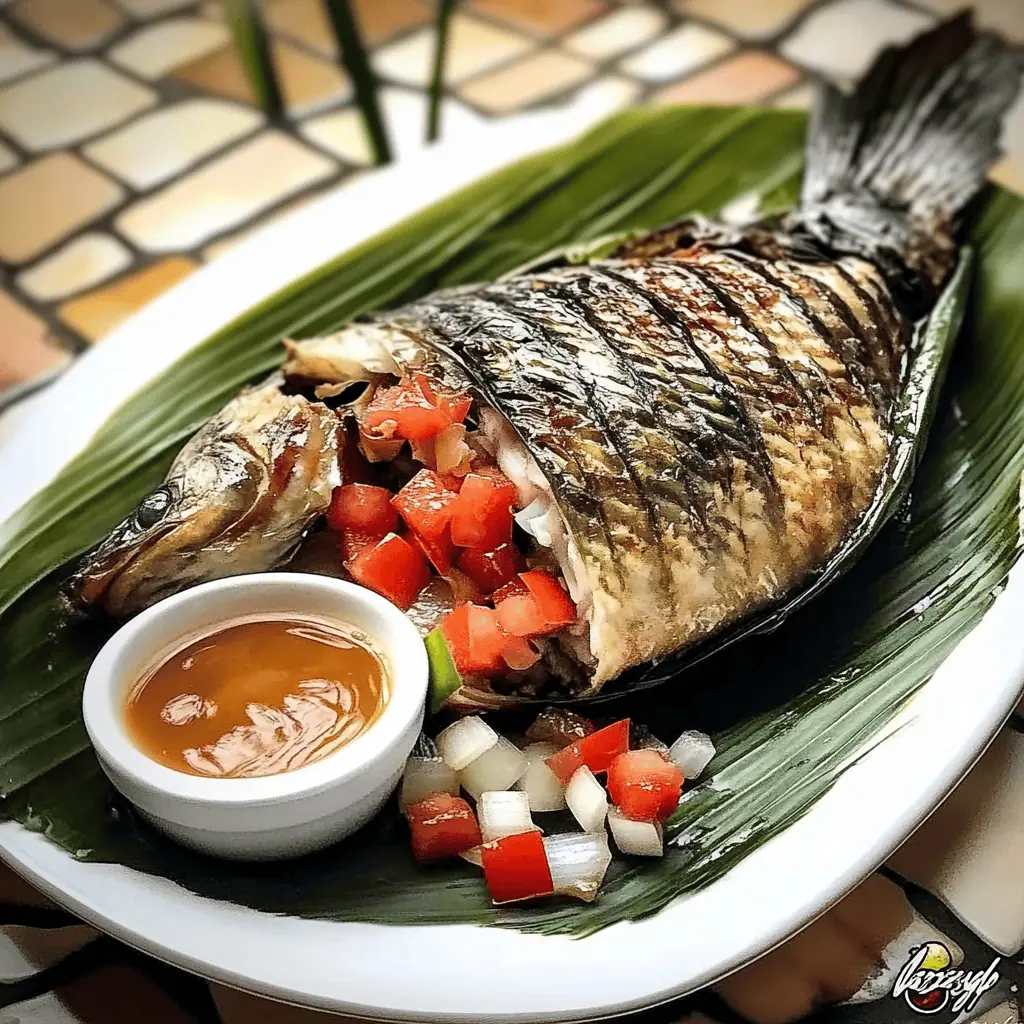
Why You'll Love This Recipe
- Restaurant Quality at Home: Create a dish worthy of special occasions using simple ingredients
- Natural Steam Cooking: The wrapping method creates a perfect steam environment, ensuring moist, flavorful fish
- Healthy Option: Low-calorie, high-protein meal with fresh vegetables
- Budget-Friendly: Uses affordable tilapia and common pantry ingredients
- Make-Ahead Friendly: Can be prepared up to 4 hours in advance
- Family Favorite: A crowd-pleasing dish that even kids love
Ingredients
Each ingredient in this recipe serves a specific purpose for creating the perfect Pinaputok na Tilapia. The tilapia provides a mild, versatile base that absorbs flavors well. Sinigang mix adds a tangy, savory dimension while helping tenderize the fish.
The aromatic trio of onions, ginger, and garlic forms the flavor foundation, while tomatoes add brightness and create natural juices during cooking. Butter enriches the dish with a subtle richness, and the simple calamansi-soy dipping sauce balances the dish with its perfect combination of salty, tangy, and (optionally) spicy notes.
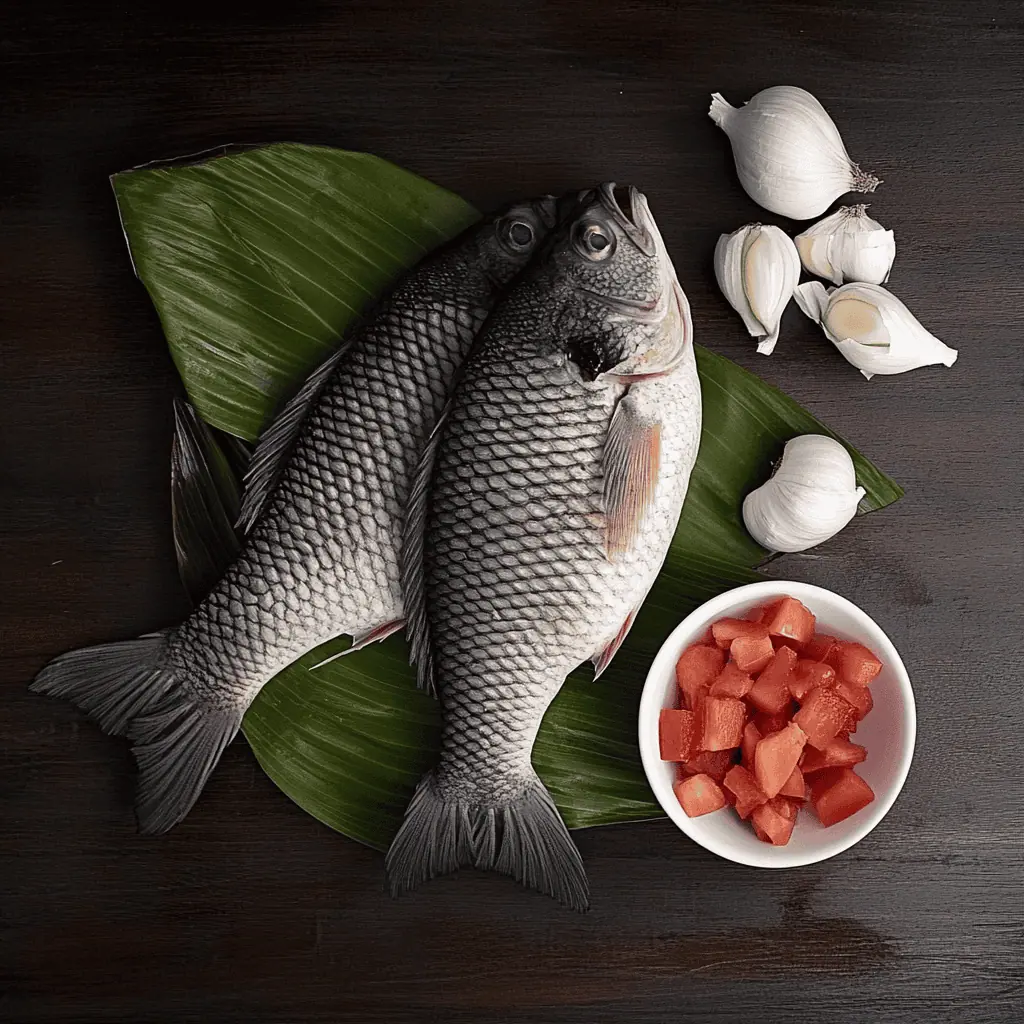
- 2 whole tilapia (about 1 pound each), scaled and gutted
- 3 tablespoons tamarind base powder (sinigang mix)
- 2 large Roma tomatoes, diced
- 1 medium white onion, finely chopped
- 1 thumb-size ginger, peeled and minced
- 2 cloves garlic, peeled and minced
- 2 tablespoons unsalted butter, melted
- Salt and pepper to taste
For the Traditional Dipping Sauce:
- 4 calamansi or 2 tablespoons lemon juice
- 3 tablespoons soy sauce
- 1-2 Thai chilies, sliced (optional)
Equipment
- Baking sheet or tray: Provides a stable surface for baking the wrapped fish
- Aluminum foil or banana leaves: Essential for wrapping the fish to create the steam environment
- Sharp knife: For scoring the fish and preparing ingredients
- Cutting board: For preparing the stuffing ingredients
- Mixing bowl: For combining the stuffing mixture
- Kitchen towels or paper towels: For patting the fish dry
- Pastry brush: For applying butter to the fish
- Meat thermometer (optional): To check if fish is properly cooked (should read 145°F)
- Small bowl: For preparing the dipping sauce
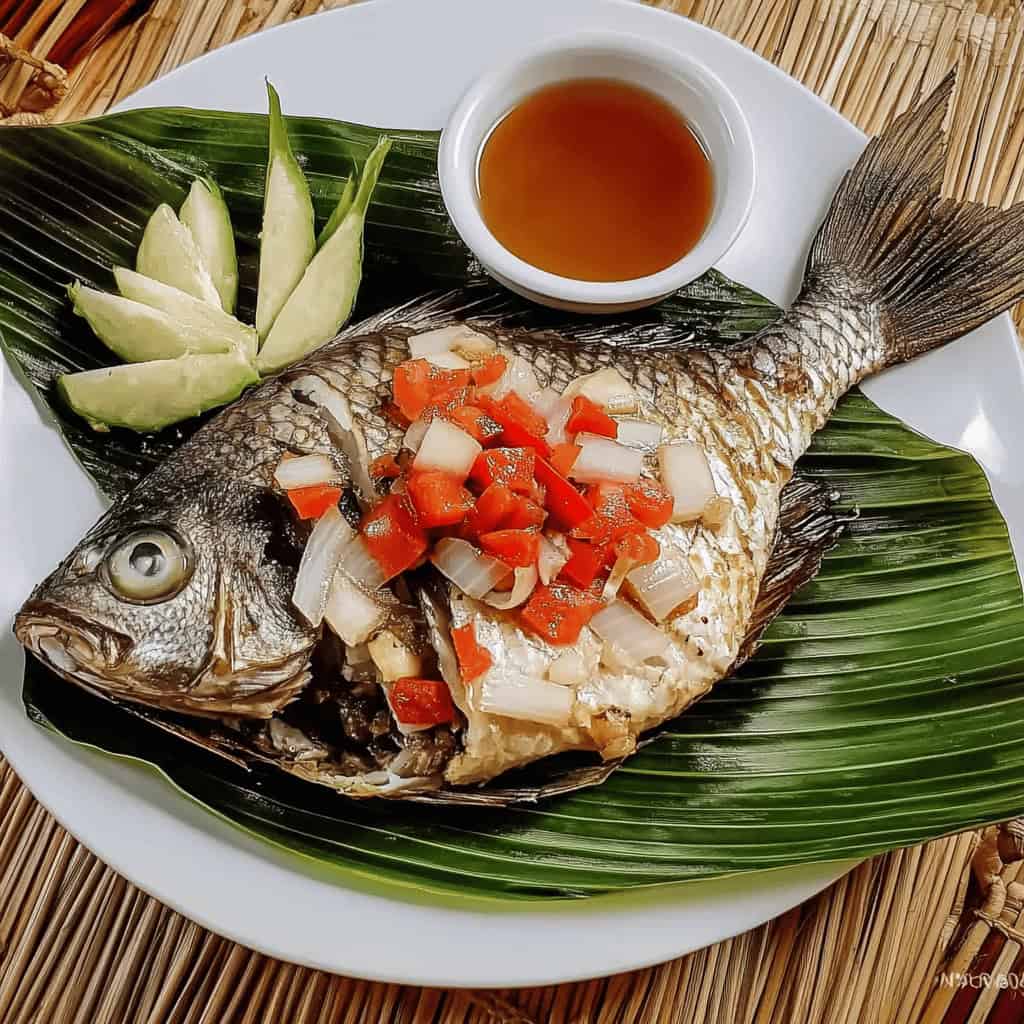
How To Make
- Preheat your oven to 375°F (190°C).
- Clean your tilapia thoroughly by removing any remaining scales and rinsing under cold running water. Pat the fish dry using paper towels until no moisture remains.
- Score the fish by making three diagonal cuts on each side, cutting almost to the bone. This helps the seasonings penetrate and ensures even cooking.
- Season the fish inside and out, including the cuts, with salt and pepper.
- Apply the sinigang mix by rubbing two tablespoons all over the fish and inside the cavity. Let the fish marinate for 10 minutes to allow the flavors to penetrate.
- Prepare the stuffing by combining diced tomatoes, finely chopped white onions, minced ginger, and minced garlic in a bowl. Add the remaining tablespoon of sinigang mix to the vegetables and season with salt and pepper. Mix thoroughly.
- Stuff each fish generously with the prepared vegetable mixture. Be careful not to overstuff, as the vegetables will release liquid during cooking.
- Brush the exterior of the fish with melted butter.
- Prepare the wrapping material. If using banana leaves, quickly pass them over an open flame or steam them briefly to make them pliable. If using foil, tear off pieces large enough to wrap the fish completely with extra room for folding.
- Wrap each fish securely, making sure to double-wrap to prevent any leaks.
- Place the wrapped fish on a baking sheet and transfer to your preheated oven.
- Bake for 20-25 minutes at 375°F (190°C). The fish is done when the wrapper is slightly puffed from steam and the fish flakes easily when tested with a fork in the thickest part. The internal temperature should reach 145°F (63°C).
- Prepare the dipping sauce while the fish is baking by combining calamansi juice (or lemon juice) with soy sauce in a small bowl. Add sliced Thai chilies if desired.
- Rest the fish for 5 minutes after removing from the oven before unwrapping. This allows the juices to redistribute throughout the fish.
- Serve immediately while hot with steamed rice and the prepared dipping sauce. Pour any juices that have collected in the wrapper over the fish for extra flavor.

Tips from Lola's Kitchen
- Select the freshest fish by looking for clear eyes, bright red gills, and firm flesh that springs back when pressed.
- Don't skimp on the aromatics – the ginger, garlic, and onions are essential for authentic flavor.
- Score the fish deeper near the backbone for more even cooking of the thicker parts.
- Create a tight seal when wrapping to trap all the steam and juices inside.
- Let the wrapped fish rest for 5 minutes after baking before opening – this redistributes the juices and completes the cooking process.
- Save the fish heads for making sinigang soup the next day.
- For the best presentation, serve directly in the opened wrapper to showcase all the colorful stuffing.
Substitutions
- Fish: Substitute tilapia with bangus (milkfish), pompano, or sea bass. Each fish brings its unique flavor profile.
- Tamarind powder: Use 2 tablespoons of lemon juice mixed with 1 tablespoon of fish sauce as an alternative.
- Calamansi: Lemon or lime juice works well in the dipping sauce.
- Fresh tomatoes: Cherry tomatoes or even canned diced tomatoes (drained) can be used.
- Butter: Substitute with olive oil or coconut oil for a different flavor dimension.
- Banana leaves: Parchment paper can be used under foil for a similar effect without the traditional aroma.
Troubleshooting
- Fish is too dry: Either reduce cooking time by 5 minutes or lower temperature to 350°F. Make sure your wrapping is completely sealed to trap moisture.
- Stuffing falls out during cooking: Use kitchen twine to secure the fish or don't cut the slits too deep.
- Fish sticks to the wrapper: Brush the wrapper with a little oil before placing the fish, or use non-stick foil.
- Not enough flavor: Marinate the fish longer (up to 30 minutes) and be generous with the seasonings inside the cavity.
- Too much liquid in the packet: Pat vegetables dry before stuffing and avoid overcrowding the cavity.
Storage & Reheating
- Refrigeration: Store leftover fish in an airtight container for up to 2 days.
- Freezing: Not recommended as the texture of the fish deteriorates.
- Reheating Methods:
- Oven: Preheat to 350°F and warm for 10 minutes in a foil packet with a tablespoon of water added.
- Microwave: Cover with a damp paper towel and heat on medium power for 1-2 minutes.
- Steamer: Steam over medium heat for 5-7 minutes until heated through.
- Best Practice: Remove any leftover stuffing from the fish before storing, and store separately.
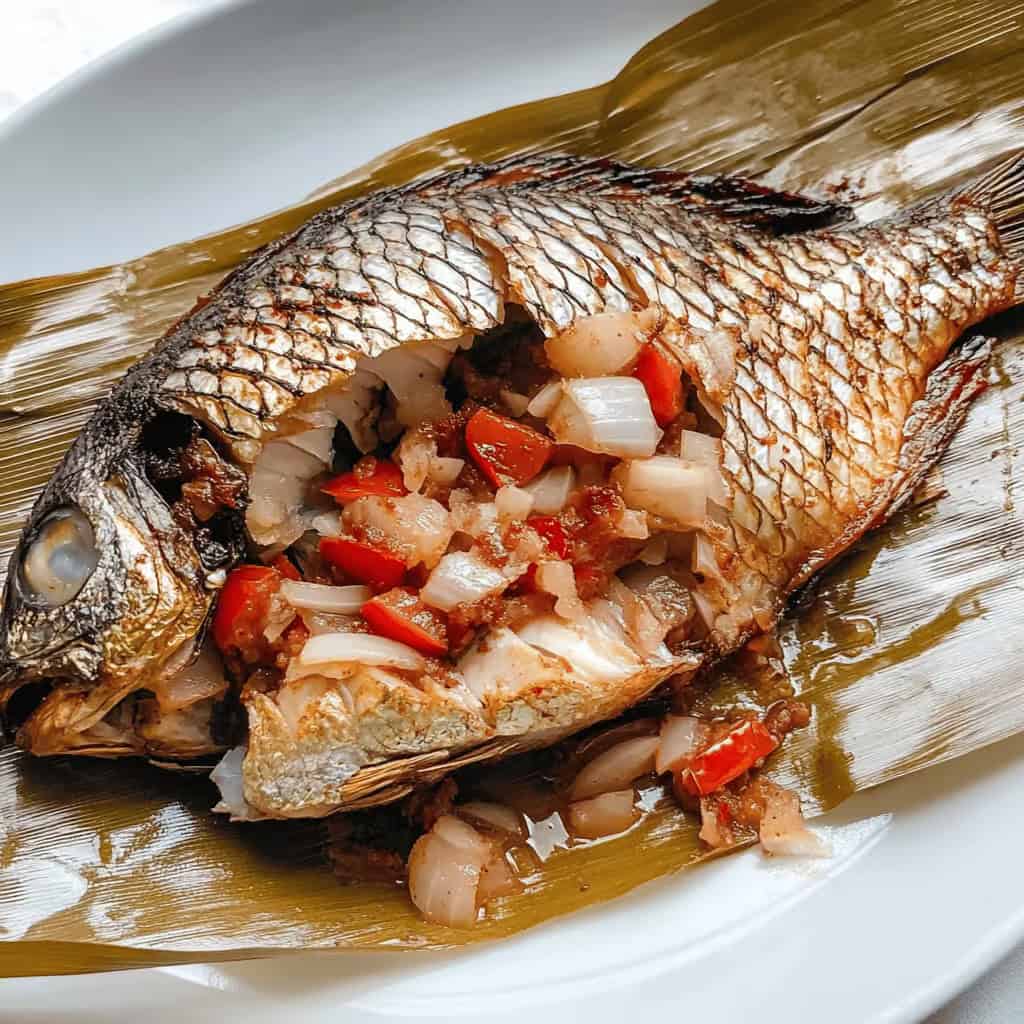
FAQ
Can I prepare this dish ahead of time?
Yes, you can prepare the fish up to 4 hours ahead. Stuff the fish, wrap it, and refrigerate until ready to bake. You may need to add 3-5 minutes to the baking time if cooking directly from the refrigerator.
How do I know when the fish is properly cooked?
The fish should flake easily with a fork when tested at the thickest part and reach an internal temperature of 145°F. The wrapper should also be slightly puffed from steam.
Can I grill this instead of baking?
Absolutely! Grill over medium heat for 15-20 minutes, turning carefully halfway through. Make sure the foil wrapping is secure to prevent flare-ups.
Is there a way to make this dish less messy to eat?
You can fillet the fish before serving, removing the center bone, but traditional Filipino style is to serve the whole fish and navigate the bones during eating.
What sides pair well with this dish?
Traditional pairings include steamed white rice, ensaladang mangga (green mango salad), or grilled eggplant. A simple cucumber and tomato salad also complements the flavors nicely.
Can I use other spices besides tamarind powder?
Yes, try a combination of lemon pepper, paprika, and a touch of cumin for a different flavor profile.
Related
Looking for other recipes like this? Try these:

Pinaputok na Tilapia (Filipino Stuffed Baked Fish)
Ingredients
For the Fish
- 2 whole tilapia about 1 pound each, scaled and gutted
- 3 tablespoons tamarind base powder sinigang mix
- 2 large Roma tomatoes diced
- 1 medium white onion finely chopped
- 1 thumb-size ginger peeled and minced
- 2 cloves garlic peeled and minced
- 2 tablespoons unsalted butter melted
- Salt and pepper to taste
For the Traditional Dipping Sauce
- 4 calamansi or 2 tablespoons lemon juice
- 3 tablespoons soy sauce
- Optional: 1-2 Thai chilies sliced
Instructions
- First, preheat your oven to 375°F (190°C). While the oven is heating, thoroughly clean your tilapia (linisin nang mabuti ang tilapia) by removing any remaining scales and rinsing it under cold running water. Pat the fish dry using paper towels until no moisture remains.
- Using a sharp knife, make three diagonal cuts on each side of the fish, cutting almost to the bone. This will help the seasonings penetrate and ensure even cooking. Season the entire fish, including inside the cavity and the cuts, with salt and pepper (timplahan ng asin at paminta).
- Rub two tablespoons of sinigang mix all over the fish and inside the cavity (ipahid ang sinigang mix sa buong isda at sa loob). Let the fish marinate for 10 minutes to allow the flavors to penetrate (palambutin ng sampung minuto).
- While the fish is marinating, prepare your stuffing mixture (maghanda ng palaman). In a bowl, combine your diced tomatoes, finely chopped white onions, minced ginger (dinurog na luya), and minced garlic (dinurog na bawang). Add the remaining tablespoon of sinigang mix to the vegetables and season with salt and pepper. Mix everything together until well combined (haluing mabuti).
- After marinating, generously stuff the cavity of each fish with your prepared vegetable mixture (punuin ang loob ng isda ng mga gulay). Be careful not to overstuff, as the vegetables will release liquid during cooking. Brush the exterior of the fish with melted butter (pahiran ng tinunaw na mantikilya).
- If using banana leaves (dahon ng saging), quickly pass them over an open flame or steam them briefly to make them pliable (painitan ang dahon para lumambot). If using foil, tear off pieces large enough to wrap the fish completely with extra room for folding. Place each fish on its wrapping material and fold to create a secure packet, making sure to double-wrap to prevent any leaks (balutin ng mahigpit upang hindi tumulo ang sabaw).
- Place the wrapped fish on a baking sheet and transfer to your preheated oven. Bake for 20-25 minutes at 375°F (190°C). You'll know the fish is done when the wrapper is slightly puffed from steam and the fish flakes easily when tested with a fork in the thickest part. The internal temperature should reach 145°F (63°C).
- While the fish is baking, prepare your dipping sauce (gumawa ng sawsawan). Combine calamansi juice (or lemon juice if calamansi isn't available) with soy sauce in a small bowl. If you like it spicy, add thinly sliced Thai chilies.
- Once done, remove from the oven and let the fish rest for 5 minutes before unwrapping (pahingang 5 minuto bago buksan). This resting period allows the juices to redistribute throughout the fish. When opening the wrapper, be careful of the hot steam that will escape (mag-ingat sa mainit na singaw).
- Serve your pinaputok na tilapia immediately while hot, with steamed rice (mainit na kanin) and your prepared dipping sauce. Pour any juices that have collected in the wrapper over the fish for extra flavor (ibuhos ang sabaw sa ibabaw ng isda).
- For storage, any leftover fish can be kept in an airtight container in the refrigerator for up to two days. When reheating, warm it in a preheated 350°F (175°C) oven for 10 minutes, or steam over medium heat for 5-7 minutes until heated through.
Tips from Lola's Kitchen
- Choose fresh tilapia with clear eyes and bright red gills
- Don't overstuff the fish - leave room for steam circulation
- Score the fish deeper near the backbone for even cooking
- Let fish rest for 5 minutes after baking before unwrapping
- Save the fish heads for sinigang soup
Nutrition
The Story Behind Pinaputok na Tilapia (Filipino Stuffed Baked Fish)
Every region in the Philippines has its signature way of cooking fish, but Pinaputok na Tilapia holds a special place in Filipino cuisine, particularly in regions blessed with abundant freshwater fish farms like Central Luzon and CALABARZON. The name itself tells a story – "pinaputok" literally means "made to explode" in Filipino, referring to how the fish appears to burst with its flavorful stuffing of tomatoes, onions, and aromatics.
This cooking method emerged from our ancestors' ingenious way of preparing freshwater fish during the pre-refrigeration era. By stuffing the fish with acidic ingredients like tomatoes and wrapping it in banana leaves, they discovered that the fish stayed fresher longer while developing a deeper, more complex flavor. The banana leaves weren't just for wrapping – they infused the fish with a subtle, sweet aroma that became an essential part of the dish's character.
In many Filipino households, particularly those near palaisdaan (fish farms), Pinaputok na Tilapia transformed from being just another fish recipe into a weekend family tradition. The dish perfectly exemplifies the Filipino cooking philosophy of "simple yet flavorful," using basic ingredients to create something extraordinary. While tilapia might be considered a humble fish, this preparation method elevates it to special-occasion status.
Modern versions of Pinaputok na Tilapia have adapted to urban kitchens, often substituting banana leaves with aluminum foil and adding contemporary ingredients like butter or olive oil. However, the core technique remains unchanged – the steam trapped within the wrapping gently cooks the fish while allowing the stuffing ingredients to create their own sauce, resulting in a dish that's both healthy and full of flavor.
The beauty of Pinaputok na Tilapia lies in its versatility. Whether you're cooking it in a traditional pugon (wood-fired oven), a modern kitchen oven, or even on a grill, the result is consistently delicious. This adaptability, combined with its impressive presentation and healthy cooking method, has helped maintain its popularity from humble provincial kitchens to upscale Filipino restaurants worldwide.
Today, as more people discover Filipino cuisine globally, Pinaputok na Tilapia stands as a perfect ambassador of our cooking heritage. It showcases how Filipinos can transform simple, readily available ingredients into a dish that's not only delicious but also tells a story of our culture, creativity, and love for sharing food with family.
Remember: Perfect pinaputok na tilapia isn't just about the stuffing—it's about achieving that ideal balance where the fish remains moist and tender while the stuffing cooks just enough to create a flavorful sauce inside the banana leaf package.
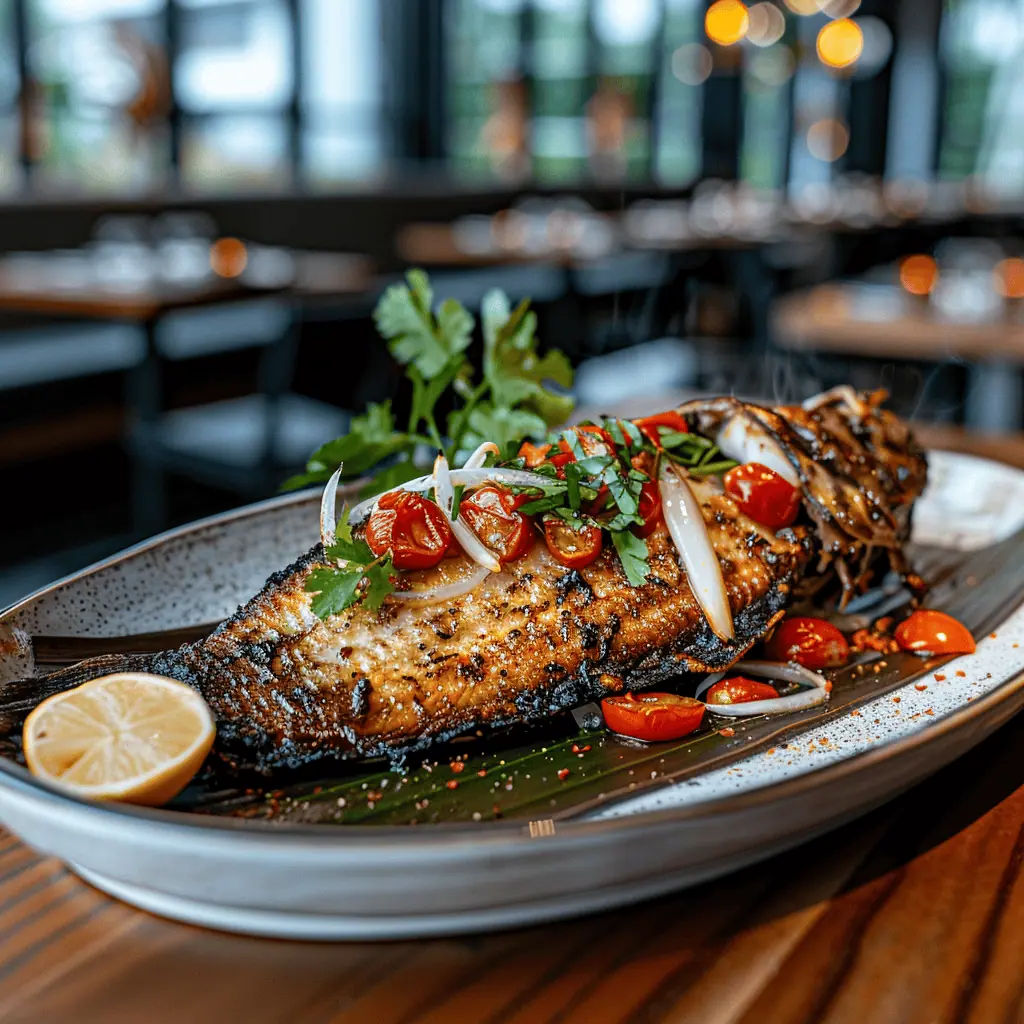









Comments
No Comments